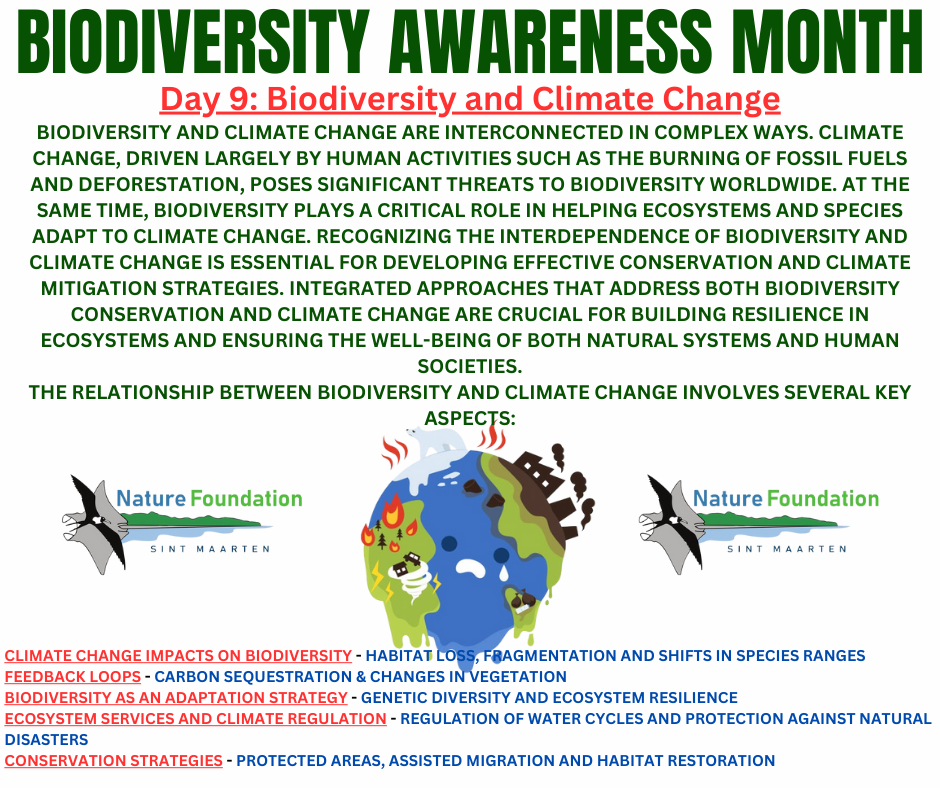Biodiversity month day 9: Biodiversity and Climate Change
Biodiversity and climate change are interconnected in complex ways.
The St. Maarten Hospitality & Trade Association supports the March Biodiversity awareness month organized by the Nature Foundation in an effort to help protect St. Maartens nature and biodiversity. Todays topic: Biodiversity and Climate Change
Climate change, driven largely by human activities such as the burning of fossil fuels and deforestation, poses significant threats to biodiversity worldwide. At the same time, biodiversity plays a critical role in helping ecosystems and species adapt to climate change.
The relationship between biodiversity and climate change involves several key aspects:
1. Climate Change Impacts on Biodiversity:
– Habitat Loss and Fragmentation: Rising temperatures, altered precipitation patterns, and extreme weather events contribute to habitat loss and fragmentation, impacting the distribution and abundance of species.
– Shifts in Species Ranges: Many species are experiencing changes in their geographic ranges as they move to cooler or more suitable habitats. Some species may face difficulty adapting or migrating, leading to population declines or extinctions.
– Altered Ecosystem Dynamics: Climate change can disrupt ecological processes and relationships, affecting the timing of events such as flowering, migration, and reproduction. This can have cascading effects on species interactions within ecosystems.
2. Feedback Loops:
– Carbon Sequestration: Biodiverse ecosystems, especially forests, play a crucial role in sequestering carbon dioxide, helping to mitigate climate change. Deforestation and habitat degradation release stored carbon back into the atmosphere.
– Albedo Effect: Changes in vegetation cover can alter the reflectivity of the Earth’s surface (albedo), influencing temperature patterns and contributing to further climate change.
3. Biodiversity as an Adaptation Strategy:
– Genetic Diversity: Biodiversity provides the raw genetic material necessary for species to adapt to changing environmental conditions. Populations with greater genetic diversity are more likely to have individuals with traits suited to new challenges.
– Ecosystem Resilience: Biodiverse ecosystems are often more resilient to climate change. A diverse array of species can buffer the impacts of disturbances, helping ecosystems recover and adapt.
4. Ecosystem Services and Climate Regulation:
– Regulation of Water Cycles: Biodiverse ecosystems contribute to regulating water cycles, including precipitation patterns and water availability. Changes in biodiversity can influence local and regional climate patterns.
– Protection against Natural Disasters: Mangroves, coral reefs, and other biodiverse ecosystems act as natural barriers, protecting coastal areas from storm surges and other extreme events.
5. Conservation Strategies:
– Protected Areas: Establishing and expanding protected areas can help conserve biodiversity, providing habitats that are crucial for species survival in the face of climate change.
– Assisted Migration: Some conservation efforts involve assisted migration, where species are translocated to areas where the climate is expected to be more suitable in the future.
– Habitat Restoration: Restoring degraded habitats can enhance their capacity to sequester carbon, support biodiversity, and provide ecosystem services that help mitigate climate change.
Recognizing the interdependence of biodiversity and climate change is essential for developing effective conservation and climate mitigation strategies. Integrated approaches that address both biodiversity conservation and climate change are crucial for building resilience in ecosystems and ensuring the well-being of both natural systems and human societies.
Back to the Visit St Maarten Main page

